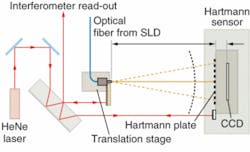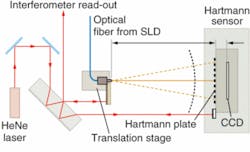Hartmann wavefront sensor is sensitive to λ/15,500
The Shack-Hartmann sensor-an array of microlenses focused on a CCD that monitors the positions of the resulting focused spots-is commonly used in adaptive optics to measure wavefront error. The older-style Hartmann sensor has no microlenses, but relies on pinholes instead, greatly reducing light throughput. But, if carefully set up, the Hartmann sensor has the potential for higher sensitivity, because of the lack of lens-induced errors. Researchers at the University of Adelaide (Adelaide, Australia) have fabricated such a sensor that reaches a sensitivity of λ/15,500 at a wavelength of 820 nm.
Intended to detect wavefront distortions in advanced gravitational-wave interferometers, the sensor includes a brass plate with 900 precisely drilled 150 µm holes spaced 430 µm apart, a 12-bit digitized 1024 × 1024-pixel CCD, and a superluminescent-diode (SLD) point light source. Hole spacings and sizes were optimized to minimize crosstalk while maintaining the proper ratio of spot to pixel size. Shifting the light source axially induces a precisely known wavefront change for testing; the results fell short of the predicted λ/21,000 because of slight changes in air temperature. Contact Aidan Brooks at [email protected].

